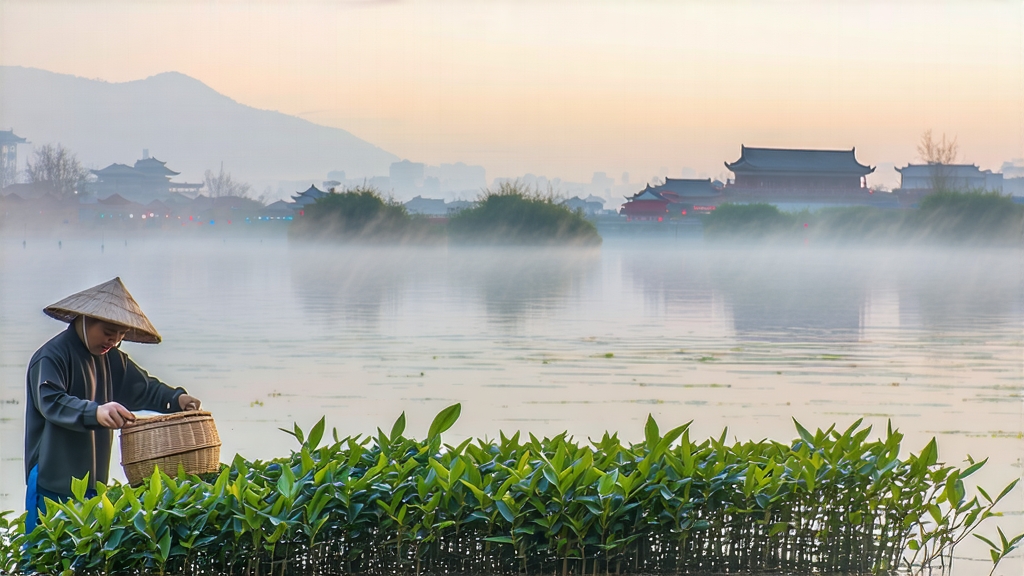
Among the pantheon of Chinese green teas, none carries a name as poetic or a leaf as petite as Biluochun. Literally “Green Snail of Spring,” the tea is prized for its tight spiral shape, downy silver tips, and a fragrance so naturally fruity that early Qing-dynasty poets claimed it “borrows the soul of peach and plum.” To international drinkers accustomed to the grassy bite of sencha or the nutty sweetness of long-jing, Biluochun offers a softer, more flirtatious introduction to the Chinese green-tea aesthetic: delicate, orchid-sweet, and oceanic, as if the mist of Lake Taihu were folded into every curl.
Historical records place Biluochun’s birth in the Dongting mountain range of Jiangsu province during the late Ming dynasty. Local legend tells of tea-picking girls who ran out of space in their bamboo baskets and tucked fresh shoots between their breasts; body heat and youthful scent allegedly imbued the leaves with an unforgettable aroma. Apocryphal though the tale may be, it hints at two truths that still define the tea: extreme tenderness of raw material and an almost perfumed cup. By the Kangxi reign (1662-1722) the imperial court had elevated the tea to tribute status, and the emperor himself renamed it from “Xia Sha Ren Xiang” (literally “scary fragrance”) to the more elegant Biluochun, noting its resemblance to tiny jade snails.
Geographically, authentic Biluochun is shackled to a microclimate. The Dongting range rises from the eastern edge of Lake Taihu, China’s third-largest freshwater body. Daily lake breezes shroud the terraced tea gardens in fog, filtering sunlight and forcing the plant to produce extra theanine and aromatic volatiles. Two cultivars dominate: the small-leaf “Dongting Qunti” landrace, genetically closer to wild tea, and the modern clonal “Fuding Dabaicha,” introduced in the 1980s for higher yield. Purists insist only the former, scattered among fruit orchards of loquat and peach, delivers the tea’s signature “ floral-fruit rhyme.” These companion trees bloom synchronously with the first flush, and bees shuttle between petals and tea flowers, an accidental but decisive step in scenting the nascent buds.
Harvest calendar is brutal: only fourteen days in late March to mid-April qualify for Mingqian grade—leaves picked before the Qingming festival when nights still dip to 8 °C. Pickers must pluck the standard of “one bud with just-opened leaf,” barely 1.5 centimeters long, at dawn while dew keeps cells turgid. Five kilograms of fresh tips—roughly 14,000 hand-picked snippets—yield one kilogram of finished tea. Such exacting standards mean a single experienced picker harvests barely 600 g per day, less than the final cup you will brew on a leisurely Sunday morning.
Crafting Biluochun is a ballet of heat, pressure, and timing collectively called “shaqing, cuotiao, wodong, tanliang.” First, the leaves are “kill-green” (shaqing) on iron pans heated to 180 °C for forty seconds; this deactivates oxidative enzymes while preserving chlorophyll. Next comes cuotiao, the distinctive rubbing-twisting phase. Using ten fingers shaped like a tea leaf, the master alternates between gentle rolling and high-speed flicking against the pan wall; the motion tightens the bud into a spiral and ruptures surface cells so fruit esters can escape later in the cup. Temperature is then dropped to 70 °C for wodong, a “nest-shaking” step in which small batches are tossed and caught to set the curl. Finally, tanliang spreads the half-dry snails on bamboo trays for thirty minutes of passive cooling, locking in fragrance. The entire cycle—from tree to finished tea—must finish within four hours, before ambient humidity re-opens the leaf pores.
Judging quality starts with sight: top-grade Biluochun displays uniform jade-green spirals, each the size of a papaya seed, densely coated in white pekoe that looks like frost. Lower grades turn olive or even yellow, the curl looser, pekoe sparse. Aroma in dry form should evoke lychee and white peach; any grassy sharpness signals under-withering, while smokiness betrays overheating. Once brewed